Kids Water, Snack, and Self-Care Station Makes Life Easier for Everyone

I’m always looking for practical ideas that can make raising (trilingual) children a little easier. A Montessori-inspired kids water, snack, and self-care station is a simple concept that has made a positive difference in our home!
I first set up this space when my son was 20 months old and my daughter was 4.5 years old. They’re now 3 and 6 years old, and this been an integral part of our daily life!
This post is part of my homeschool tour series which focuses on creating a prepared environment for surviving and thriving at home!

Chalk Academy is reader-supported. Some of the links are affiliate links. When you buy something through an affiliate link, we may earn a very small commission at no cost to you. Details here.
Why a kids water, snack, and self-care station helps the whole family
A designated kids water and snack station is inexpensive to set up and encourages independence and self-care.
Water is one of the most important parts of the daily diet, and we try to make it easily available for our children.
When kids drink enough water, their bodies function at their best.
In addition, most kids need 1-2 healthy snacks each day. Their little stomachs fill up fast, and they burn energy quickly!
Besides, the less my kids ask for help, such as with refilling their water cups or grabbing a snack, the more they learn and develop confidence in meeting their needs.
When they do more for themselves, I have more time for other important tasks.
I can get work done, prepare fun bilingual learning activities, research Chinese children’s books, or simply sit on the couch and relax for a moment!
I’ll share what we’ve learned by setting up a water, snack, and self-care station for my 6-year-old daughter 老大 (lǎodà / oldest child) and 3-year-old son 老二 (lǎo èr / second child).
Here’s a “before” picture when my kids were younger:
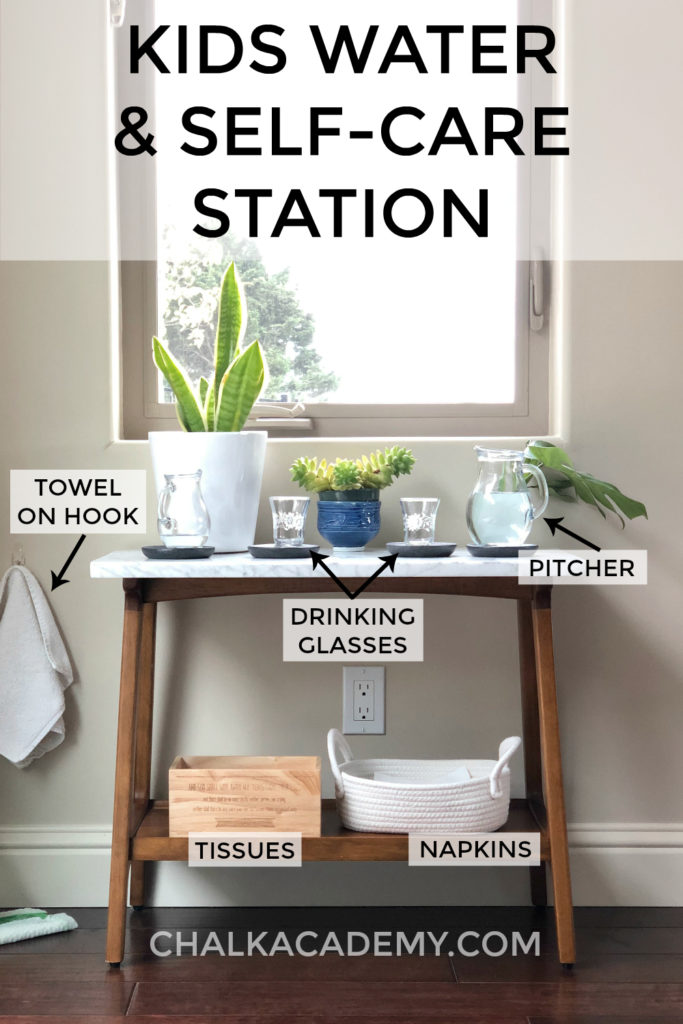
And here’s the “after” picture with the addition of kids’ cleaning supplies!
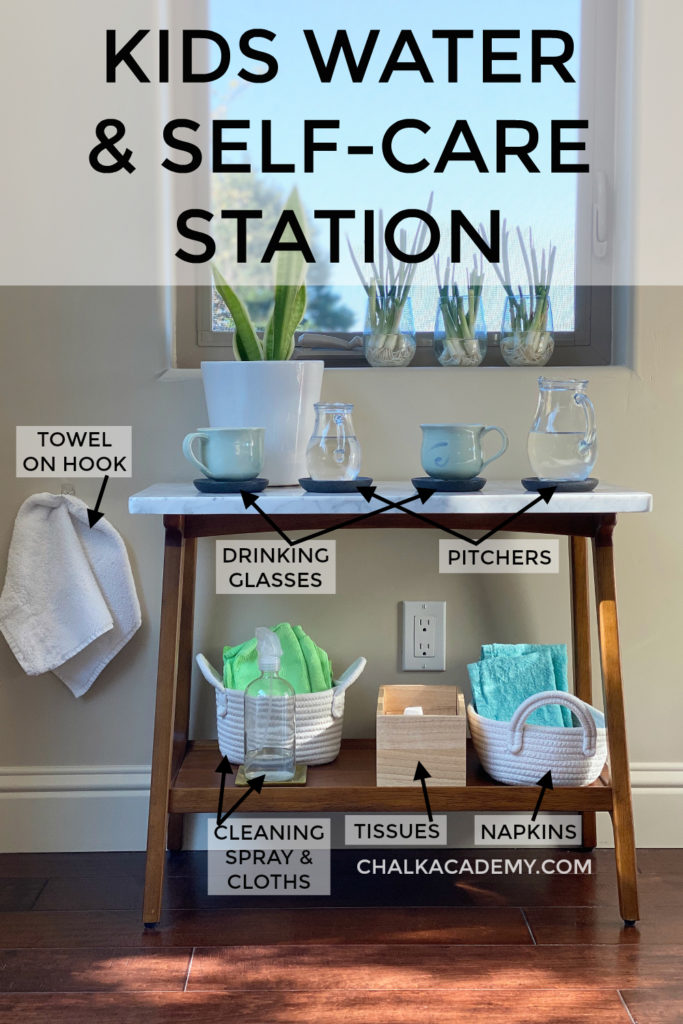
What’s in our kids’ water and snack station
- Small side table (similar options here and here)
- Small cups (similar here)
- Coasters (similar here) to encourage putting cups back
- 18oz glass pitcher for my 6yo; 9oz glass pitcher for my 3yo
- Healthy snacks in easy-to-open containers
- Open basket with napkins
- Wall hook with towel for spills
- Tissue box
- Microfiber cloths and glass spray bottle (plastic option here)
- Plants!

Here’s a closer look at some of the details!
Location of the kids water and snack station
Our kids water and snack station consists of a small table in our kitchen and dining area.
The table is next to a window so they can look outside while hydrating!
Other parents have showed me their rolling cart and tabletop trays to fit their personal kitchen space!
Open-cup versus straw cup for kids
Many pediatricians, dentist, speech specialists, and registered dietitians recommend transitioning to an open cup or straw cup between age 6 months to 1 year.
Sippy cups should be avoided because of the hard spout.
On the other hand, both open and straw cups promote oral-motor and swallowing skills, which in turn can improve speech skills.
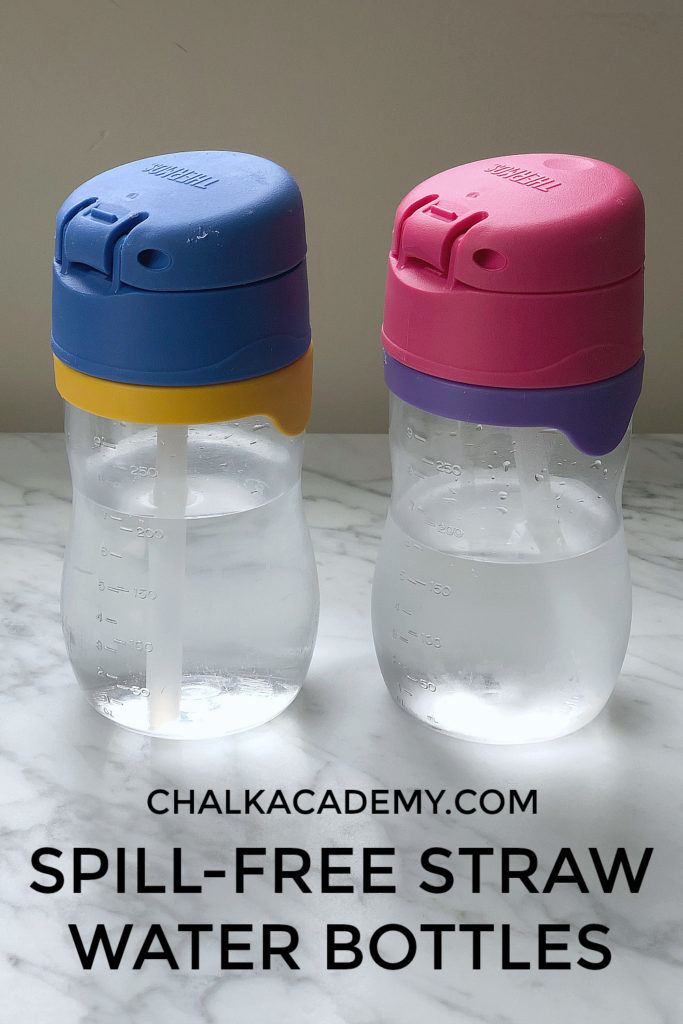
Pros and cons of straw cups
Open cups can be intimidating to parents because of the potential for spills.
On the other hand, straw cups are convenient for minimizing mess.
Straw cups are also incredibly useful for children with disabilities who do not have the motor coordination for an open cup.
After trying numerous plastic straw cups that leaked or molded, we finally settled on these straw cups.
Unfortunately, over the years, despite gentle discouragement of straw chewing, my 老大 bit through almost 10 of these silicone straws!!!
In addition to being a choking hazard, this straw problem was creating environmental waste.
When my 老二 started biting through the same straws, I was ready to try open cups.
Benefits of open cups
Both kids took a few weeks to get used to drinking from open cups.
We started with small glass shot glasses that we dusted off from the top of our kitchen cabinet. Currently, my kids are using ceramic tea cups that my mother-in-law made.
As expected, my son spilled a lot during the first few days, but he quickly learned how to pour carefully!
Like most kids, they still sometimes need reminders to take 喝水 (hē shuǐ / drink water), but they drink so much more compared to before.
Also, open cups are so much easier to clean compared to straw cups, which means they can wash their own cups!
Plus, at restaurants, my children are comfortable with drinking from regular glass cups which means less waste of single-use plastic straws and “kiddy cups.”
While they have accidentally broken 1 or 2 glass cups, trusting them with natural materials has been part of the learning process.
If you’re comfortable with glass, these glass tumblers have hundreds of 5 star reviews for being more durable than regular glass.
However, if you don’t feel comfortable with glass, that’s understandable!
Small steel mugs and tritan drinking glasses are great alternatives, too.

Kid-friendly water pitchers
Some families opt for large water dispensers, but we prefer pitchers which take up less table space and are easy to wash.
For my 6-year-old daughter, an 18 ounce glass pitcher keeps her hydrated for most of the day.
Over the past year, my 3-year-old son has been able to easily pour the 9 ounce glass pitcher. However, since he has been drinking more than 2 pitchers a day, I am going to get him the larger 18 ounce glass pitcher and donate the smaller one to a friend.
If you don’t want to buy a special pitcher that kids will eventually outgrow, you can simply use a measuring cup which can also be used for baking!
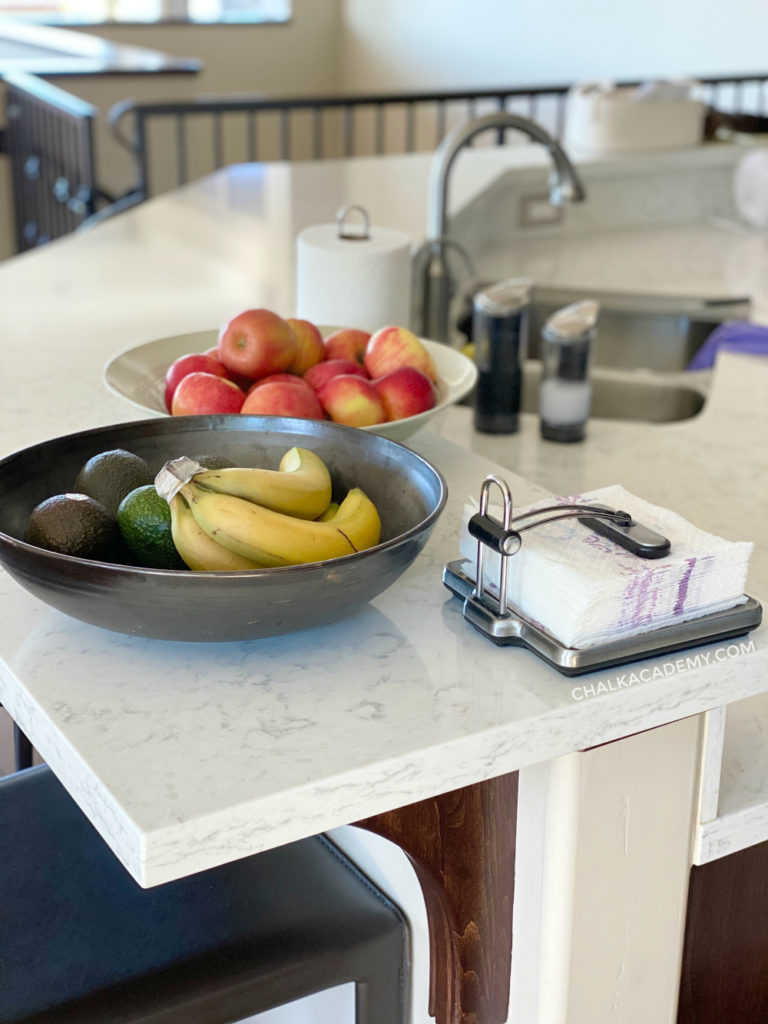
Healthy snack station for kids
As a pediatrician who is concerned about the obesity epidemic, I strongly believe that healthy food needs to be the visible choice for the whole family.
Since my son has severe food allergies to dairy, egg, sesame, and tree nuts, coming up with a range of healthy, attractive options has been quite the challenge.
For his safety, to minimize the risk of accidental cross-contamination, we have eliminated food with any of those ingredients in our home.
Needless to say, this has significantly eliminated a lot of common snacks!
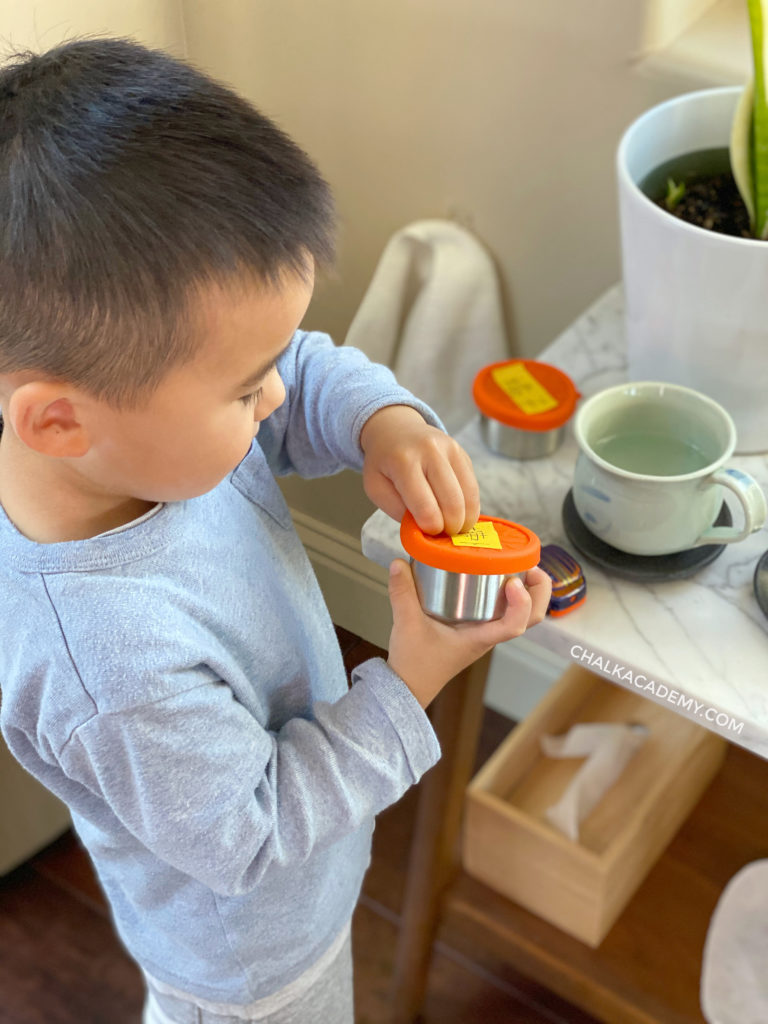
The silver lining of my son’s allergy is that we are all much healthier for eating more fresh and less processed foods.
Nutritious, allergy-safe snacks
Over time, we’ve figured out nutritious snack options including:
- Seasonal fresh fruit eg, blueberries, strawberries, clementines, bananas, apples, peaches
- Sliced cucumbers (sometimes cut into cute shapes with mini cutters)
- Raw shredded carrots or roasted carrot chips (note: raw baby carrots are a choking hazard for toddlers)
- Roasted chic peas / garbanzo beans – 2 cans of garbanzo beans with olive oil and garlic salt, roast at 400 degrees for 25 minutes or until desired crunch, toss once or twice for even cooking
- Roasted edamame – same instructions as above
- Tofu
- Whole grain bread
- Peanut butter (consider almond butter or sun butter if your child is allergic)
- Soy yogurt
Packaged snacks like roasted seaweed snacks with olive oil and Made Good granola snacks (top 9 allergy-free) are usually reserved for outings.

Easy-to-open snack containers
Snacks are typically stored in easy-to-open stainless steel containers at this water and snack station.
My kids do not need permission to have these snacks as I want to encourage autonomy. Nevertheless, they like to announce when they are snacking as if to request confirmation, just as they like to share when they are going to the bathroom haha.
Containers are labeled with Chinese characters to create a print-rich environment in our minority language.
The containers replicate my daughter’s school experience of designated snacks.
This also helps with portion control so my kids still have an appetite for lunch and dinner. Family meals are important to our family, and my son would literally eat 5 bananas a day if he could!
After they are done eating, they put the containers in the sink to be washed later.


Easy access to cleaning and self-care
- A small Command wall hook holds a towel that the kids can grab to wipe spills and hang back by themselves. Previously, I used to keep a towel on the floor. However, adding a wall hook has made a big difference! Rather than tossing the towel onto the ground, the hook encourages them to mindfully hang up the towel.
- We recently switched to cloth napkins and love these aqua chambray linen napkins and these blue chambray napkins from Crate and Barrel!
- My kids actually fight over who gets to wipe down the dining table! Microfiber cloths and a glass spray bottle (plastic option here) are easily accessible so that cleaning is an expected part of the routine.
- Washable baskets hold the towels and napkins.
Special, personal parts of our kids water and snack station
The next few items are just personal touches to make this area special for my kids.
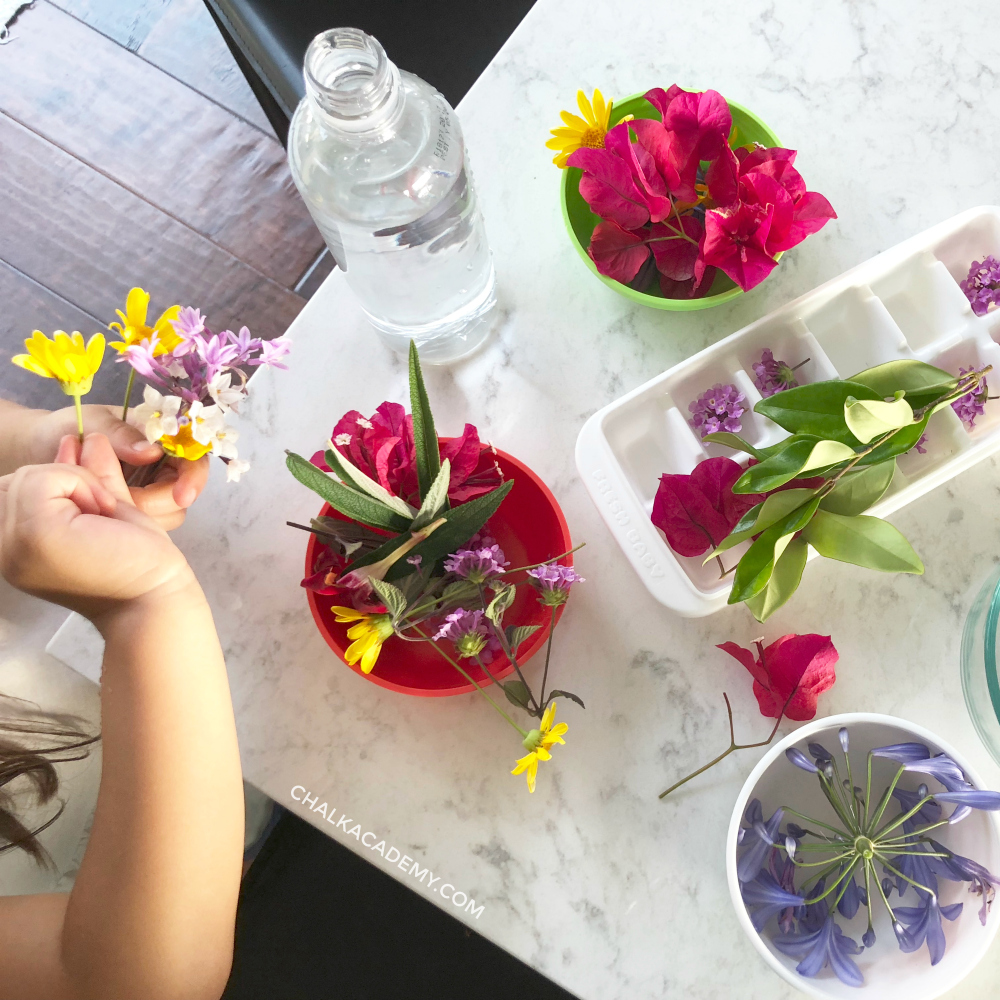
Fresh flowers and low-maintenance plants
During the spring and summer, my daughter enjoys creating flower arrangements.
I love that this brings the beauty of nature plus her creativity to their table!
Occasionally, the kids also help water the low-maintenance succulent plants.
However, plant care is an area my husband and I are gradually learning about.
To be honest, we have failed to keep most house plants alive, but these plants have been surviving for a few years!
Water and self-care stations shared by other families
Here are a couple set ups that other families shared with me! I hope you find a solution that fits your family’s space and needs!
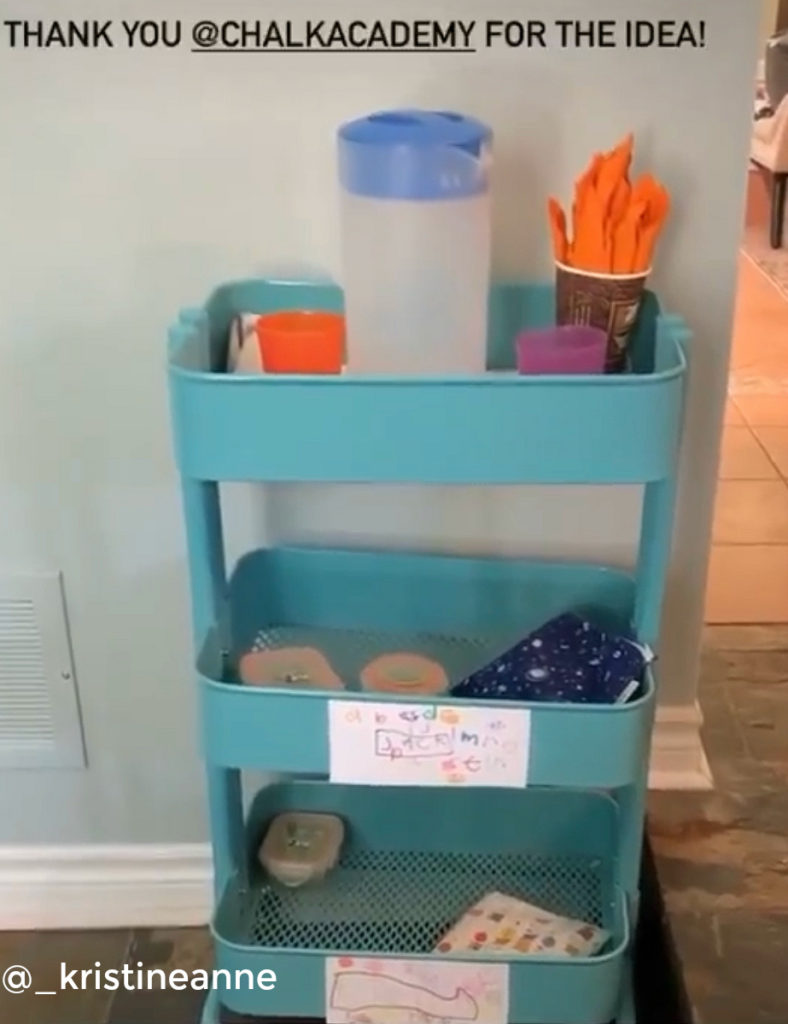
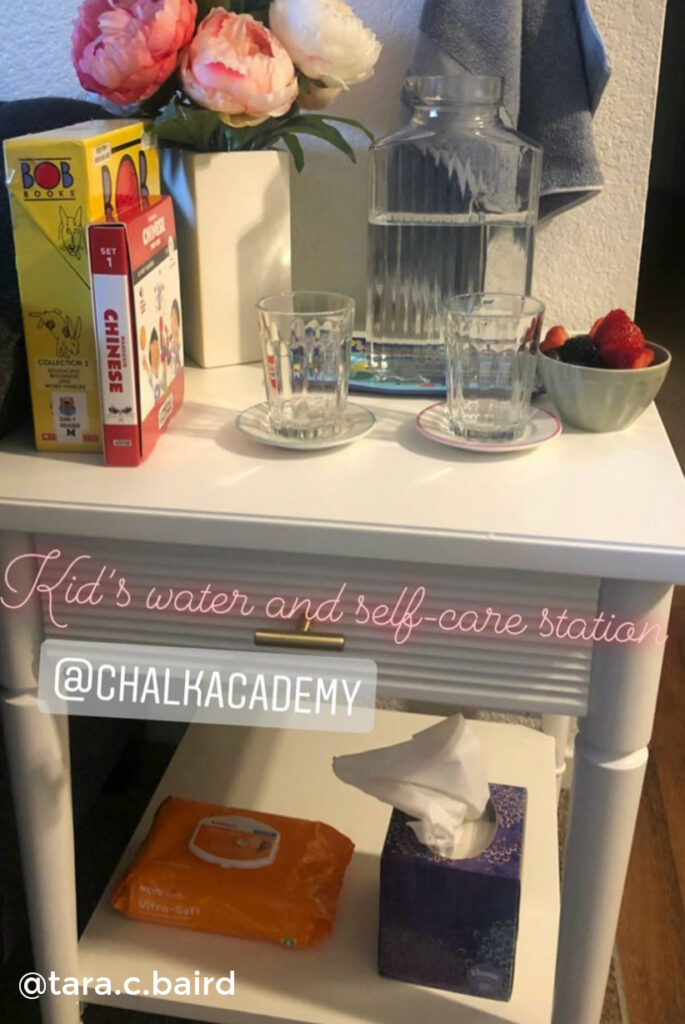
Do you have a water, snack, and self-care station for your kids?
What challenges have you experienced with encouraging kids to drink and eat healthily?
What changes have made a positive difference for your family?
Please leave a note below – I’d love to learn about your family’s journey!
Creating a prepared learning environment at home
- Play Area / Homeschool Room Before and After: 11 Tips for Decluttering
- Art Storage and Organization with Kids
- Homeschool Tour: Mid-Century Modern Meets Montessori (old tour…I’ll post an updated tour soon!)
- 15 Smart Ways to Motivate Your Child to Read
Thanks for the tip about the hook for the cloth! I am always running to grab the cloth for my girls to wipe up spills and they are told to bring it back to the sink but that’s a lot of work on my part: I think a hook for the cloth would make that whole process much more autonomous as I believe I can trust them to get it from the hook and then put it back. 🙂